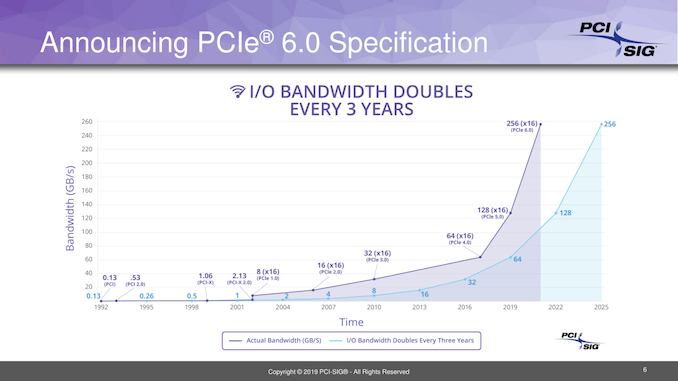PCIe 6.0 Dev Reaches v0.3; On-Track for a Full Specification In 2021
by Ryan Smith on October 15, 2019 10:30 AM EST
Having wrapped up their work on the PCI-Express 5.0 specification earlier this year, the PCI-SIG wasted no time in getting to work on the next version of the specification, PCIe 6.0. That specification, which is expected to be finished in 2021, will once again double PCIe’s bandwidth to 64 GigaTransfers/second – or roughly 128GB/sec (each direction) for a x16 slot – thanks to some high-end encoding technologies like PAM4.
At the time that PCIe 6.0 was first announced, the group was just beginning work on the specification. And now a few scant months later, the group has released a brief update, announcing that they have already completed version 0.3 of the new spec.
The announcement itself is light on technical details, as the design goals and major underlying technologies for PCIe 6.0 were announced at the very start of the project. However the organization is keen to ensure that PCIe development continues moving at a steady pace, to avoid repeating the long gap between 3.0 and 4.0.
And the group’s members will certainly be busy. Even with the 0.3 specification in hand, it’s going to be nearly another two years before the specification is done, reflecting on the fact that there’s a lot of work left to be done to solve the technical challenges in developing PCIe 6.0, and bringing new signaling standards into the specification while maintaining backwards compatibility.
Source: PCI-SIG










45 Comments
View All Comments
Duncan Macdonald - Tuesday, October 15, 2019 - link
Will PCIe 6 be usable with plug in cards ? The frequencies are high in the microwave spectrum with a wavelength of under 1/2 cm. Good microwave engineering will be needed even for motherboards - the PCIe connector is not a tightly specified microwave component. There is also a question about the power consumption of the interface chips as power requirements rise with frequency.proflogic - Tuesday, October 15, 2019 - link
For what it's worth, the signal bandwidth should be similar to PCIe 5.0, right? With PAM4, we're getting even more into analog signaling, with 4 voltage levels and 2 bits per symbol.Ryan Smith - Tuesday, October 15, 2019 - link
Correct. PCIe 6.0 is using PAM4 specifically to avoid having to increase the signal frequencies.I don't believe the PCI-SIG has officially stated that PCIe cards are going to be supported, but as they are for PCIe 5.0, there's no reason they shouldn't work for 6.0 since the signal frequencies aren't changing.
thomasg - Monday, October 21, 2019 - link
The frequencies actually won't increase this time; that's why they're moving to PAM4.Same frequency, higher symbol-density.
So this time it's not about increasing frequency at all, it's all about increasing the signal-to-noise ratio.
yeeeeman - Tuesday, October 15, 2019 - link
I can also leak you the fact that pcie 7.0 is already in the mind of some guys and will appear in 2025 products. Ah, and pcie 8.0 will be in someone's head in 2021 and will reach products in 2030. Shall I continue with the leaks?jordanclock - Wednesday, October 16, 2019 - link
This isn't a leak. This is an actual release from PCI-SIG about their progress towards PCIe 6.0.PeachNCream - Tuesday, October 15, 2019 - link
Too bad VESA Local Bus never took off. It was a huge upgrade over ISA and there were only a few things wrong with it like slot lenght, wiring complexity, connector cost, lack of components, and that stupid PCI standard which turned out to be too slow for video cards anyhow so we ended up with AGP slots. In fact, Micro Channel never really got the fair shake it deserved either because of how poorly IBM handled licensing. It was as stupid as BluRay and Betamax in that regard.Qasar - Tuesday, October 15, 2019 - link
" It was as stupid as BluRay and Betamax in that regard. " how so ?PeachNCream - Wednesday, October 16, 2019 - link
Several reasons - VHS, streaming, and microplastics mainly.Qasar - Wednesday, October 16, 2019 - link
vhs, only over took betamax, cause of a certain industry chose it over the other, same with blueray i believe, and, wasnt there a licensing fee to use betamax, vs no fee for vhs ??streaming.. pffft... IMO, cant compete with the video and audio quality of blueray..... yet, as you still loose some quality due to compression, and then having to stream it...